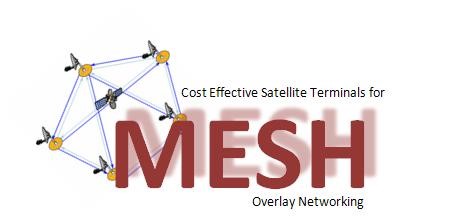PAGE CONTENTS
Objectives
The MESH Project is a project aimed at implementing two different Test-Beds to fully characterize some new air interfaces and techniques in a MESH Overlay Networking based on DVB-S2/RCS2 specifications in terms of achievable system performance. The first developed Test-Bed is capable of emulating in real time a complete SatCom System implementing the DVB-RCS2 specifications, including Time Slot Sharing (TSS) and Single Carrier Frequency Domain Multiple Access (SC-FDMA), applicable to both LOS and NLOS conditions and both aggregate and not-aggregate types of traffic. The Test-Bed, implemented as SW applications supported by suit HW modules, includes three L-Band terminals supporting several functionalities from physical layer to upper layer, a Hub and the Network Control Centre (NCC). The second Test-Bed is capable of emulating in real time the physical layer of the return link to validate the Continuous Phase Modulation (CPM) using a fully software platform for each of three CPM terminals composed of CPU and GPU. Additionally realistic hardware channel emulators for return links are embedded in the Test-Beds.
Challenges
The key challenges of the project can be summarized as follows:
- implement air interfaces, some already used in other standards (i.e. LTE), to satellite communications
- implement air interfaces and techniques that permit to save bandwidth and simplify the terminal architecture
- implement the Dynamic Connectivity Protocol (DCP) in order to manage the MESH connectivity
- implement a software terminal to be used as a reference for a future product able to increase the performances in term of data rate
use an already available product (Proteus Modem provided by AIRBUS D&S) in order to reduce the time to market
Plan
The project was divided in four different phases:
- Phase 1: air interface study and preliminary architecture
- Phase 2: consolidation of the solutions studied in phase 1, terminal and test-bed architecture definition and implementation of the proposed air interfaces
- Phase 3: optimization of Phase 2 implementation, in terms of speed, and terminal preliminary integration.
- Phase 4: terminal and test-bed integration and system performance validation
Current Status
Project completed


